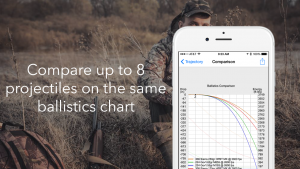On the Range with Ballistic:
Big, Bad Bullet Drop – Ballistic to The Rescue!

Bullet drop. It keeps long-range shooters awake at night, and has long-range hunters glued to their Ballisticapp when they are afield.
How much drop? At what distance? If you go from Load A to Load B, each with a different muzzle velocity, what’s the drop now?
The information you input to your Ballistic app will calculate the drop of your bullet and various distances. Yet, some shooters don’t quite understand that the smallest changes in the shooting environment can greatly influence just how much a bullet may or may not drop, especially as shooting distances lengthen.
Gravity, of course, is a constant factor in bullet drop, and Ballistic automatically calculates for this very important factor.
However, many other factors are at work, too. For example, air resistance progressively slows a bullet, but, what determines the air resistance in any particular shooting scenario, primarily air temperature.
According to Curt Vaughn, Head of Product for Ballistic, and a long-range shooting competitor, temperature differences don’t impact the actual path of the bullet. Yet, the air temperature very much influences how fast gunpowder burns and therefore how much pressure your round develops. Higher air temps equal higher velocities, all other factors being equal.
For example, when a .243 Ackley Improved handload of Vaughn’s is fired at 20 degrees Fahrenheit, it has a muzzle velocity of 3,175 fps, staying super-sonic out to 1,350 yards. But when it’s 80 degrees? Now, the muzzle velocity is 3,286 fps, and the bullet remains super-sonic out to 1,450 yards.
Likewise, Vaughn adds, barometric pressure, “is immensely important in making long-range shots, and needs to be factored into your calculations.”
In general, the higher the barometric pressure, the more drag the air applies to the bullet. For example, with a temperature at 50 degrees Fahrenheit, and a barometric pressure of 30.00 inches, at Sea Level, bullets from Vaughn’s .243 AI handloads travel approximately 1,400 yards at super-sonic speed before they drop to sub-sonic. However, the same load, same rifle and location, but with the barometer reading 27.00 inches? Now those rounds have a maximum super-sonic range of 1,550 yards.
To accurately calculate your bullet drop, make sure you input these and other environmental factors into your Ballistic calculations. Ballistic features a one-touch atmospheric correction tab to more detailed inputs, as well as numerous other factors, to put you on target fast and with great precision.

